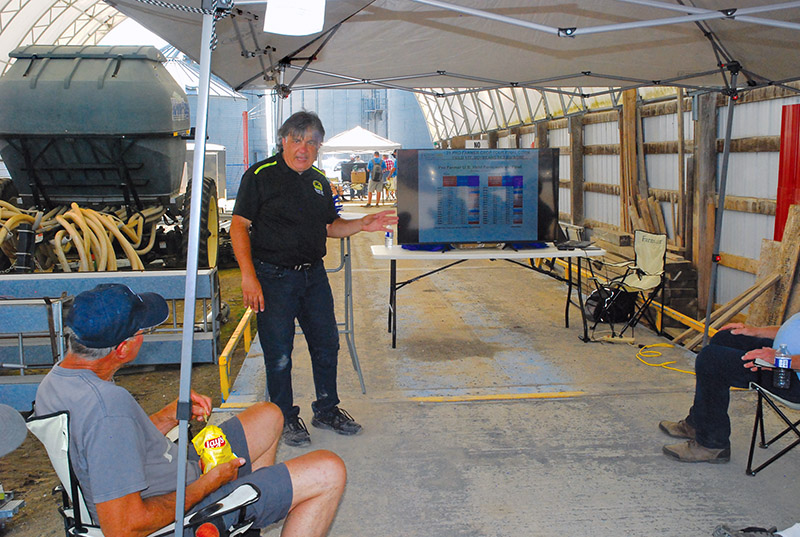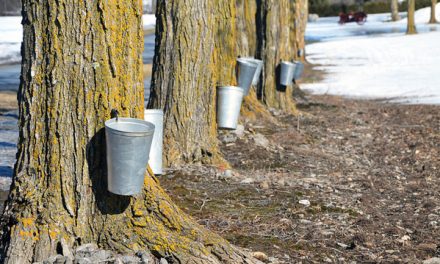Moe Agostino explained the need for good meaningful risk management practices to those visiting the Great Ontario Yield Tour on Thurs. Aug. 26. Morin Photo
From the mud on his or her boots to the sunburn on the neck of an Ontario farmer, the 2021 6th Annual Great Ontario Yield Tour held at Derks Elevator in Chesterville on Aug. 26, featured a wealth of information.
Topics ranged from 2021 grain and market and basis outlooks with Moe Agostino to yield tour results for Eastern Ontario from Leigh Hudson-Templeton, territory manager with Maizex Seeds, with a presentation about drone technology thrown in for good measure.
The news is cautiously positive for farmers looking into the future, but there will be challenges.
There were more than 100 people registered for the event, which included six different stations for groups to visits and hear a total of 12 different informative presentations.
This year’s tour was sponsored by Farms.com Risk management, Alpine, Maizex and Derks Elevator.
The Crop Weather Outlook 2021 and Beyond was virtually presented by Elwynn Taylor a climatologist from Iowa State University. His presentation was about the 89-year drought cycle and its impact on Ontario.
His main concern was what was going on with corn and soybeans.
“Both crops are sensitive to soil, fertility, light and temperature, to daylight. All of these things are factors we are concerned with,” he said.
He explained that the Chinook wind is a major factor affecting weather west of James Bay.
The air that moves west to east in Canada for example, cools down and picks up moisture when it slides over western mountain ranges then picks up heat as it descends down the other side heading toward the praries. It arrives at the lower elevation as warm dry air.
“This can reach into Western Ontario,” said Taylor.
He mentioned the North American Drought Monitor that included the United States and in Canada. You can find the map showing the United States at www.cpc.ncep.noaa.gov/products/predictions/814day/ and a Canadian version at https://agriculture.canada.ca/en/agriculture-and-environment/drought-watch-and-agroclimate/canadian-drought-monitor
Using historical data from the United States and Canada about the corn yield during good and bad times drought-wise he suggested that, “climate risk in agriculture is likely to be greater during the next 20 years than in the past 20 years.”
He said knowing how to manage risk will become increasingly important.
“There will be greater risk for production of crops,” he said.
That reality makes the management of risk more important in the coming decade or two. He suggested that risk has increased in the past. “With this 89 year cycle the very worst year in the 48 states (United States) for crops in the first part of the cycle was in 1846 and 1847. The next time it was that bad was 1935-36, now the next time is into 2025.”
Taylor said in the coming years, Ontario, Saskatchewan parts of Quebec and Manitoba will be affected to varying degrees.
Taylor believes that periods of drought are inevitable, but they will not be as bad as the ones in the 1800’s or as in 1936. He said 2025 will be the next year of the drought cycle and hopefully better than in the past despite being serious.
Preparing to deal with bleak weather conditions, global supply and demand challenges and increasing input costs for farmers is something that farmers have to face head on, and that is when risk management becomes important.
Moe Agostino from Farms.com is its resident risk management expert.
He explained that there has never a better time to pay attention to how you view risk management regarding your farm operation. He suggested that everyone pay close attention to the presentation by Elwynn Taylor.
“Listen to him,” he said. “You have to wrap your head around this because if you don’t you are going to make a lot of management, production and marketing mistakes.”
Agostino’s concern was that decisions made without factoring in the many variables affecting the present day farming industry could have serious consequences. The margin of error for farms is shrinking.
“Don’t be so worried that you are going to miss something if you do not pull the trigger,” he said. He suggested that the market was fairly volatile and subject to frequent changes.
He used what was currently happening to western farmers with the drought they are going through as a cautionary tale.
“Don’t think that cannot happen in Ontario,” he said.
He noted that a town in Siberia had recorded a temperature of 100 degrees.
“I know genetics are better, technology’s better, and I know farm management practices are better, but you still need rain,” he said.
He showed a chart that showed record precipitation for the area in August of 2016. “You do not have that this year.”
Agostino said to the group at his station, “I have one message for you and one message only. Do not book 2022 until you have this covered.”
The concern is that if a farmer sells his or her crop at whatever the current price is and the price goes up because of increasingly worrisome factors such as supply and demand and the weather, there will be an issue when all of the other input costs a farmer has to deal with go up, and price of crop does not keep pace.
“Everyone wants to wait for a break but you are not going to get it,” he said.
The Maizex presentation featured Leigh Hudson-Templeton who explained,
“There is some good potential out there in the corn crop, estimated at 180-190 bushels/ac. (4.5-4.8mt/ac.); if the weather allows it to finish. We need rain across the region and we are losing kernel depth the longer we go without rain. We haven’t had a good rain for three weeks in most areas.”
On average, hybrids are pushing rows around on the lower range of hybrid character (ie. 18-20 hybrids are pushing more 18 rows round than 20s) as a result of the dry spring and the frost.
“Despite this, we made up for it, with the ample amount of rainfall we got during July and at pollination resulting in excellent cob length and tip fill. Plant stands are 30,060 ears/ac., which is less than the provincial average of 30,600 ears/ac. These losses are a result of a variety of factors, but compaction, seedbed preparation, seeding depth and frost were contributing factors to early season losses in the corn stand. On average, the anticipated average seed drop is 33-34,000 seeds/ac.”
Hudson-Templeton talked about how to reduce the 3,000 plant/ac. Loss.
“We cannot hide from the compaction issues that we are seeing anymore. The rain that we received in July hid a lot of these issues, but now we can see them everywhere. Two inch compaction layers are evident in a lot of fields as a result of the warm April to a cold/wet week to hot dry May, and the land that was prepared in April, baked anything with clay in it; creating a horizontal compaction layer. The roots don’t lie. The lack of frost in the fall during corn harvest, followed by a mild winter, also is contributing to this issue,” she said.
There is ample Western Bean Cutworm (WBC) damage across the area, despite the relatively low trap collections. The worst pressure is found in areas that have seen it in the past, corn on corn acres, and lighter soils.
She said, “We are even seeing it up in Pembroke. Scouting is becoming a challenge with egg masses being hard to find and peak flight being later than pollination timing. Scouting needs to change to be more diligent in controlling this pest as it continues to evolve.”
Soybeans are expected to be an average crop with an estimate of 50-54bu/ac. (1.3-1.5mt/ac.), with replanted acres estimated to be 36-50bu/ac. (1-1.4mt/ac.).
“There is white mould present across the region. Fields that were planted in April or prior to May 12th, have more nodes and more 3-4-bean pods, and are the same height as the stands planted after this time period. There is also heavy frog eye leaf spot in acres that were not sprayed with a fungicide. This leaf disease can rob up to 20 per cent of your yield if it gets severe,” she said.
Plant populations are also trending lower due to a dry spring, shallow planting, frost and poor residue management. Replanted beans are around the R5 stage, while the ones that were not are pushing R6-R6.5.
“Pod fill is in jeopardy with the dry weather we are getting and will affect overall seed size and stands that are not as advanced as others. There are not many stands that have the top clusters filling.”













